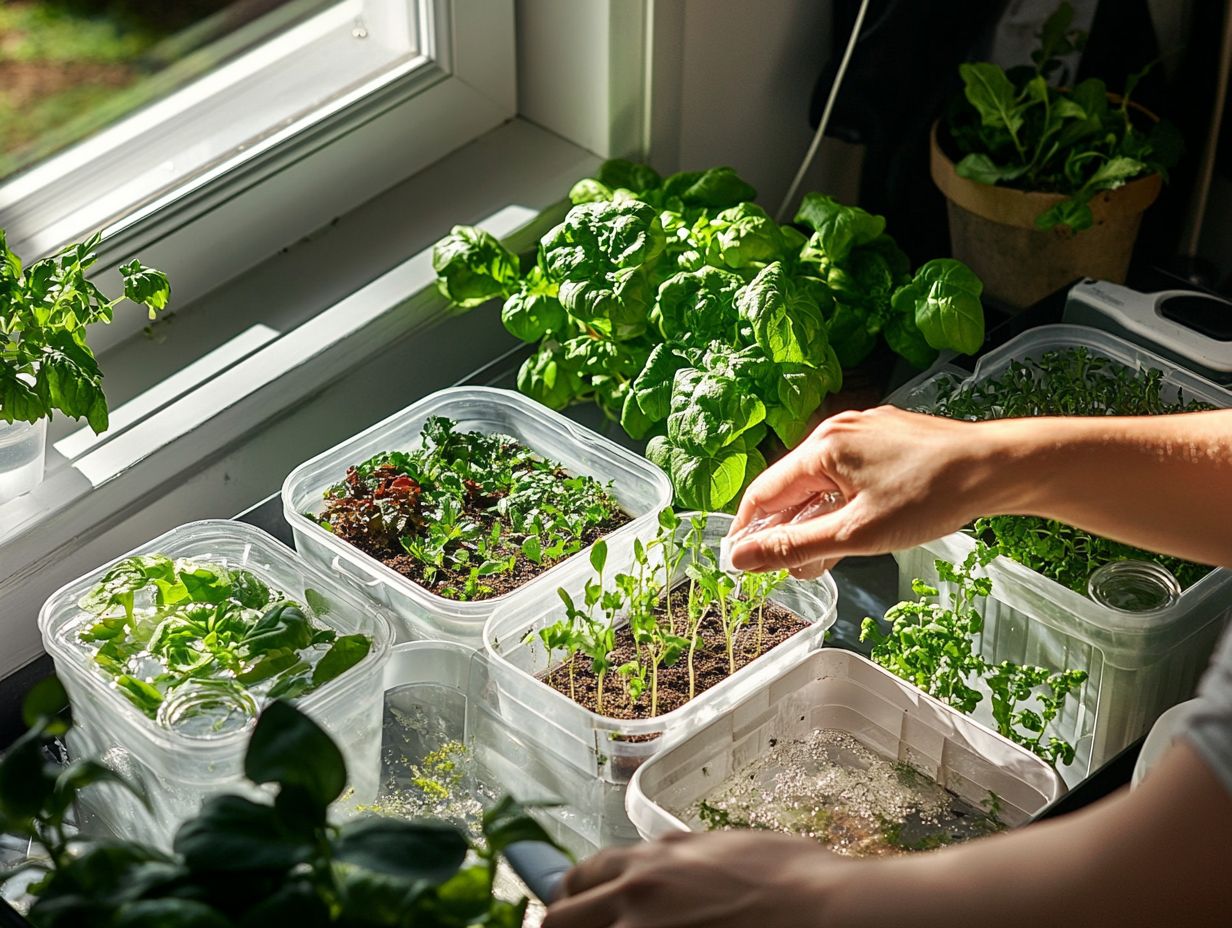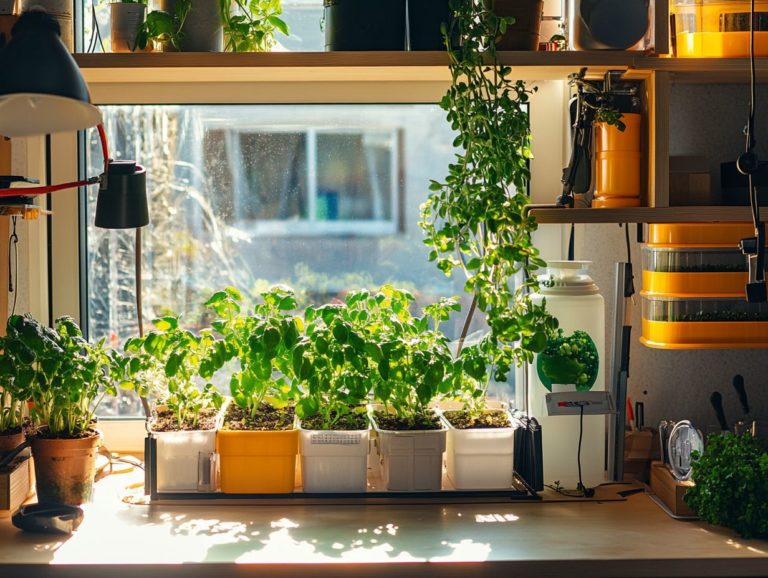How to Make a Hydroponic Container Garden
Hydroponic container gardening opens the door to a world of amazing benefits! This innovative method not only maximizes your yield but also allows you to enjoy fresh produce from the comfort of your home throughout the year.
Explore the myriad advantages of hydroponic gardening compared to conventional methods, and learn how to choose the perfect containers for your needs. You’ll find detailed, step-by-step guidance for setting up your system effortlessly.
Get ready to grow your own delicious food at home!
Contents
- Key Takeaways:
- Benefits of a Hydroponic Garden
- Choosing the Right Container for Your Garden
- Setting Up Your Hydroponic System
- Planting and Maintaining Your Garden
- Harvesting and Using Your Hydroponic Garden
- Frequently Asked Questions
- What makes hydroponic gardens effective using PVC pipe?
- What are the benefits of making a hydroponic container garden?
- What materials do I need to make a hydroponic container garden?
- How do I set up a hydroponic container garden?
- Can I use any container for a hydroponic garden?
- Do I need to have a green thumb to make a hydroponic container garden?
Key Takeaways:

- Hydroponic gardening offers many benefits, including faster growth, less space needed, and reduced water usage compared to traditional gardening methods!
- Choosing the right container is key to your success! Consider factors such as size, material, and drainage to ensure optimal plant growth.
- Setting up a hydroponic system may seem daunting, but following step-by-step instructions and using quality materials can make the process easier and more successful.
What is Hydroponic Gardening?
Hydroponic gardening is your gateway to growing plants without the hassle of soil. By using water mixed with plant food, you provide essential nutrients directly to the roots, creating an innovative gardening experience.
This method allows you to cultivate a variety of plants think fresh herbs, juicy tomatoes, and crisp lettuce both indoors and outdoors in stylish containers.
The beauty of this system lies in its components: water reservoirs, grow lights, and net cups. This makes it a versatile choice for urban farming and sustainable living. If you’re interested in starting your own garden, check out this guide on how to start a hydroponic herb garden. You’ll maximize your space while enjoying efficient watering in a compact design, perfect for both novices and seasoned gardeners.
By embracing hydroponic systems, you can significantly reduce the risk of pests and diseases often found in traditional soil gardening. The nutrient-rich water is essential; it delivers important macro and micronutrients straight to your plants, resulting in faster growth and impressive yields.
This method frequently incorporates growing plants on top of each other to save space, allowing you to grow more plants in smaller footprints ideal for those with limited outdoor space. Hydroponic gardening not only conserves water but also promotes healthier plant growth, making it an increasingly appealing option for the environmentally conscious.
Benefits of a Hydroponic Garden
Hydroponic gardening presents a wealth of amazing benefits, making it an appealing choice for those who prioritize sustainable living and efficient gardening practices! This innovative method accelerates plant growth through optimal nutrient delivery while significantly reducing water usage, rendering it an environmentally conscious option for urban agriculture.
Hydroponic gardens are easy to set up in compact spaces. This facilitates year-round cultivation of vegetables and herbs, enhancing food security and adding a touch of convenience to your culinary endeavors.
Ready to dive into hydroponic gardening? Let s get started!
Advantages Over Traditional Gardening
Hydroponic container gardening offers many advantages over traditional methods. It is more efficient and better for resource management.
Unlike soil-based gardening, hydroponics lets you control nutrients and watering precisely. This reduces the risk of over or under-watering.
As a result, plants grow faster and yield more. It s ideal for urban farming or small spaces.
This innovative approach lets you grow vertically, perfect for balconies, patios, or small backyards. With less weeding and pest control, you can enjoy your plants more.
Hydroponics also cuts water consumption by recycling moisture effectively. This aligns with sustainable practices that are crucial today.
By embracing hydroponic gardening, you can enjoy fresh produce while conserving resources.
Choosing the Right Container for Your Garden

Choosing the right container is essential for your hydroponic container garden. It directly impacts plant growth and your system’s efficiency.
You can use PVC pipes, storage containers, or specialized hydroponic kits to create the right environment.
Consider size, drainage, and compatibility with plant support systems when selecting a container. This attention to detail helps with light penetration and oxygen replenishment.
Factors to Consider
When picking a container for your hydroponic garden, you must consider vital factors. Size, drainage, and maintenance accessibility are key for a healthy garden.
Adequate light penetration significantly influences plant development and yield. Different plants have varying root space requirements.
Larger plants need more room, while smaller seedlings thrive in compact spaces. Proper drainage prevents waterlogging, which can cause root rot.
Don’t overlook light exposure. Ensure your containers receive optimal sunlight or artificial light for maximum growth.
Setting Up Your Hydroponic System
Setting up your hydroponic system involves essential steps for a successful gardening experience. From choosing a DIY hydroponic design to integrating components like a water pump, each part is crucial.
Understanding how these systems work together can help you create a thriving hydroponic garden tailored to your needs.
Step-by-Step Instructions
To successfully establish your hydroponic garden, follow these meticulously crafted instructions that will guide you through the installation and assembly of essential hydroponic components. Start by preparing your chosen container, ensuring it has proper drainage and is compatible with your water and air pumps.
Once you’ve set that up, fill the container with the appropriate nutrient solution. For those interested in optimizing their setup, check out how to set up a deep water culture system. Arrange your grow lights to maximize light penetration for your plants.
After your setup is complete, it s important to monitor the pH levels and temperature of the nutrient solution consistently. pH levels measure how acidic or basic your nutrient solution is. Aim for a pH level between 5.5 and 6.5, which is ideal for most plants. Maintain the nutrient solution at around 68 F for optimal nutrient absorption.
Equip your grow lights with a timer to provide a consistent 12-16 hours of light each day. Air circulation is crucial; utilizing fans can strengthen plant stems and help maintain an even temperature.
Remember to periodically check for algae growth and clean your system to prevent clogs. This will ensure your hydroponic garden remains vibrant and efficient.
Planting and Maintaining Your Garden

Successfully establishing and nurturing your hydroponic garden requires a keen awareness of your plants’ specific needs and a commitment to creating optimal growing conditions. Whether you re cultivating herbs, lettuce, or a variety of other vegetables, your careful attention to detail will pave the way for a flourishing hydroponic setup.
Consistently monitoring water levels, nutrient concentrations, and light exposure are essential maintenance tasks that significantly enhance plant health and productivity. With this diligence, you ll be well on your way to achieving a vibrant and bountiful garden.
Tips for Successful Growth
To achieve successful growth in your hydroponic garden, implement effective strategies and practices. Focus on providing optimal light conditions and grow lights, maintaining proper nutrient management with nutrient solution and plant nutrients, and diligently caring for your plants to encourage robust and healthy growth.
Regularly check light penetration and adjust nutrient solutions and nutrient-rich water to help ensure your garden thrives and delivers a bountiful harvest.
Incorporating a systematic approach to plant monitoring and maintenance tasks will improve your results. By frequently measuring pH levels, nutrient concentration, and electrical conductivity to optimize nutrient solution, you’ll be able to make timely nutrient adjustments. Keeping an eye on plant health indicators and root systems will help you diagnose potential issues early on.
Consider varying light wavelengths along with energy savings; this can boost growth rates and promote flowering in certain plants. Maintaining clean water systems and efficient watering while ensuring adequate airflow is crucial for oxygen replenishment. These factors play a significant role in preventing diseases and optimizing plant performance!
Harvesting and Using Your Hydroponic Garden
Harvesting from your hydroponic garden presents a great chance to indulge in fresh, homegrown produce from your vegetable garden. By understanding the optimal time to harvest your growing herbs like cilantro and the best methods for storing your vegetables in a suitable storage container, you can maximize their flavor and nutritional benefits.
Employing techniques for preserving and utilizing your harvest for sustainable living not only enhances your cooking but also contributes to a more sustainable lifestyle.
Ways to Use Your Homegrown Produce
Using your homegrown produce from a hydroponic garden opens up a delightful world of culinary possibilities. It enables you to craft delicious and nutritious meals with salad. With fresh salads and flavorful garnishes at your fingertips, the versatility of your ingredients can truly elevate any dish.
By exploring various cooking methods and incorporating a range of vegetables like lettuce, tomatoes, and basil, you can significantly enhance your culinary skills.
These fresh ingredients can serve not just as the foundation for colorful salads but also be roasted to unlock their natural sweetness, enhancing flavors in kale. They can be tossed into pastas for added texture or blended into vibrant sauces that explode with flavor. Imagine the joy of harvesting fresh basil or cilantro from your garden to create aromatic stir-fries or zesty salsas.
Utilizing your homegrown veggies and DIY hydroponic systems in meal prep can simplify weeknight cooking. This makes nutritious meals not only accessible but also enjoyable. Embracing these seasonal delights transforms any ordinary dish into a delicious dish, showcasing hydroponic gardening and celebrating the true essence of homegrown food. To learn more about maximizing your efforts, check out this guide on how to use hydroponics for indoor gardening.
Frequently Asked Questions

What makes hydroponic gardens effective using PVC pipe?
A hydroponic container garden is a type of gardening where plants are grown without soil, using a nutrient-rich solution for seedling propagation (starting plants from seeds) and a water-based system.
What are the benefits of making a hydroponic container garden?
There are many benefits to making a hydroponic container garden, including increased plant growth and yields, reduced water usage, and the ability to grow plants in small spaces, making it ideal for vertical farming (growing plants upwards).
What materials do I need to make a hydroponic container garden?
You will need a container, a water reservoir with a water pump for efficient watering, a growing medium (material that supports plant roots) to hold net cups, possibly using rockwool plugs, a nutrient solution, and plants. Optional materials include a grow light, pH testing kit, and water thermometer.
How do I set up a hydroponic container garden?
First, fill the container with your chosen growing medium. Then, add the water reservoir and connect the water pump. Fill the reservoir with the nutrient solution and adjust the pH level. Finally, plant your chosen plants in the growing medium and turn on the water pump.
Can I use any container for a hydroponic garden?
Yes, you can use almost any container for a hydroponic garden as long as it is waterproof and large enough to accommodate your desired plants. Some popular choices include plastic buckets, storage totes, and even old plastic bottles.
Do I need to have a green thumb to make a hydroponic container garden?
No, you do not need to have a green thumb to make a hydroponic container garden. This type of gardening is often easier and more forgiving than traditional soil gardening, making it a great option for beginners.






